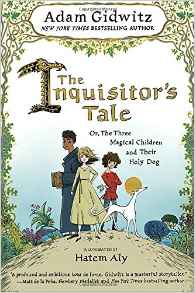This one-of-a-kind novel blends medieval history, fantasy, humor, adventure, and philosophical questions that have vexed the ages.
*The Inquisitor’s Tale, or, Three Magical Children and Their Holy Dog by Adam Gidwitz, illuminated by Haten Aly. Dutton, 2016, 384 pages
Reading Level: Middle grades, ages 10-12
Recommended for: ages 10-up
Holy Cross-Roads Inn, outside Paris, March 1242: a nameless agent of King Louis IX (the legendary “St. Louis”) is on the trail of three young people who happen to be on the King’s Most Wanted list.
“So,” I say, rubbing my hands together. Does anyone know anything about these kids? The wanted ones? And their dog?”
Turns out he’s picked the perfect place to ask, because the patrons of the inn seem to have known one or more of “these kids” personally: Aron the butcher, Marie the Brewster, Gerald the chronicler, and most of all, a little nun with a sly smile and a taste for ale. Among these travelers, the tale of three magical children spins out. Jeanne is a peasant girl who falls into trances and sees visions. Jacob is a young Jew, victimized by “Christian” thugs who burned his village down. William is the son of a crusading lord and his African mistress, a giant of a youth now studying for holy orders. They have a pet: Gwenforte, a greyhound who died heroically and was resurrected and is now venerated by illiterate villagers. And they have a nemesis: the “Red, Fat, and Wicked” friar, Michelangelo di Bologna. And finally, they have a mission: to deliver a treasure to the abbey fortress of Monte-St. Michele before the King’s men, and a vindictive queen-mother, catch up to them.
After sorting out many characters and grasping the main plot thread (first few chapters are a little confusing), the story skillfully builds. The title characters learn to respect and trust each other, friends are revealed as enemies and vice versa, and heartbreak leads to triumph in a stirring conclusion. An effortless blend of medieval detail, contemporary snappiness, and slightly gross humor (there’s nothing like a dragon with deadly farts!) keeps the reader engaged. But the story becomes more than an entertaining read when it veers into philosophy and theology. Most reviewers cite the themes of religious and social tolerance. Well and good, but while making that point the author brings in some of the most vexing questions of the ages, such as How can a good God tolerate evil? and How do we know what’s good? An orthodox Christian will disagree with some of the answers, but all readers will find lots to talk about (see below). The author doesn’t stop talking, either; see his extended author note for more background and discussion-fodder. “Illuminations” in the manner of a medieval manuscript are worth attention (and smiles) all on their own.
Cautions: Violence (semi-graphic), Language (limited use of medieval cursing, such as “God’s wounds,” etc. Most uses of God’s name are in reference to GOD)
Overall Rating: 4.5 (out of 5)
- Worldview/moral value: 4
- Artistic value: 5
Discussion questions:
- See the discussion about telling right from wrong, pp. 234-235. Michelangelo summarizes this way: “I believe [conscience] is the voice of God, telling me what to love and what to hate.” In the context, do you agree? How does Romans 1:20-21 support/not support this view?
- 262: “If God would save their souls, surely, surely he would save Jacob’s too. What difference was there between them, except the language in which he prayed?” What difference do you see between Jacob and William? Does the Bible offer any support for your view?
- 287. Here’s a long quote from Cretien the troubadour: “Listen! . . . Life is a song, composed and sung by God. We are but characters in His song. Hildebrand doesn’t think his song is beautiful. He’s either going to kill his son or die himself. It’s not beautiful to him at all. But that’s because he can’t hear it. He’s in it. You can’t hear a song you’re in, right?” What does this suggest to you about life, suffering, God’s participation—or anything else?
Support our writers and help keep Redeemed Reader ad-free by joining the Redeemed Reader Fellowship.
Stay Up to Date!
Get the information you need to make wise choices about books for your children and teens.
Our weekly newsletter includes our latest reviews, related links from around the web, a featured book list, book trivia, and more. We never sell your information. You may unsubscribe at any time.
We'd love to hear from you!
Our comments are now limited to our members (both Silver and Golden Key). Members, you just need to log in with your normal log-in credentials!
Not a member yet? You can join the Silver Key ($2.99/month) for a free 2-week trial. Cancel at any time. Find out more about membership here.
2 Comments
Leave a Comment
You must be logged in to post a comment.


I just found your site! I’m very thankful for your review, because with four avid reading children, I cannot possibly read every book before they do. A special thanks for the discussion questions!
We’re glad the discussion questions are helpful!